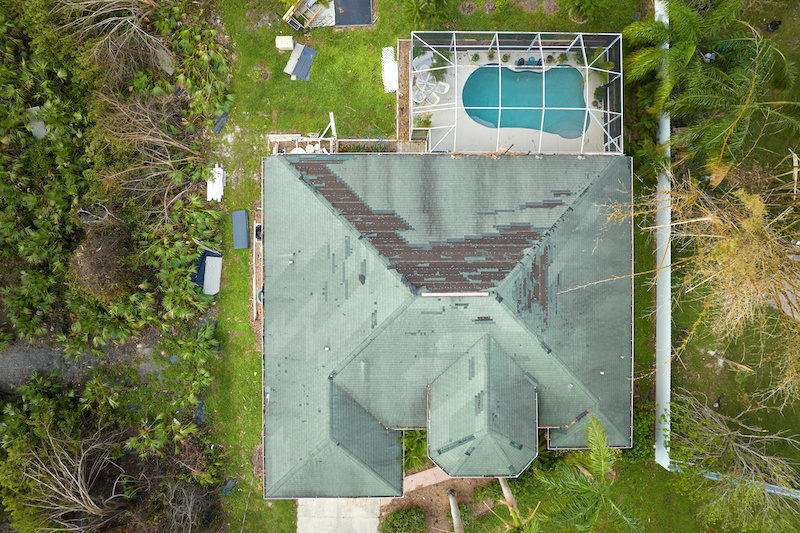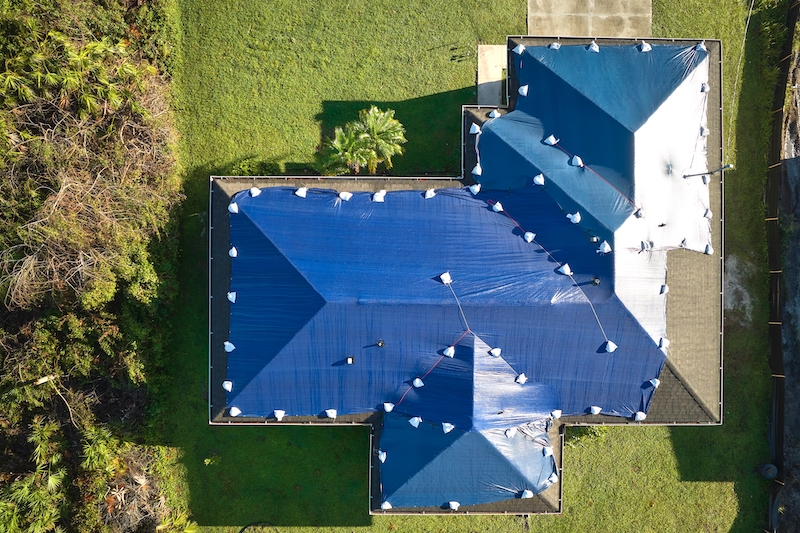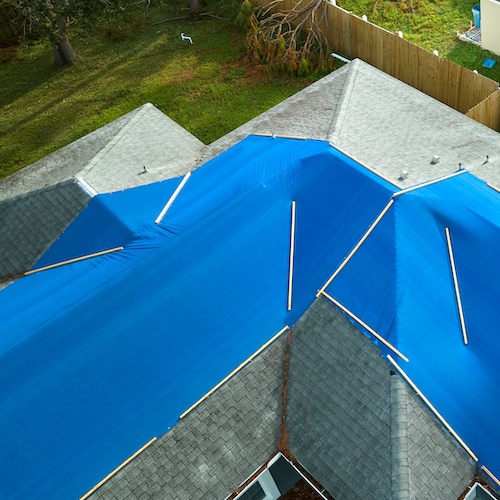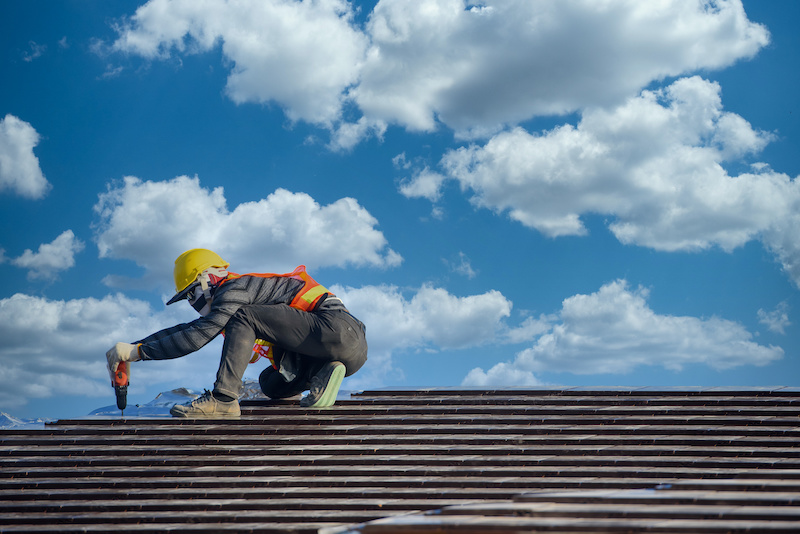Table of Contents:
- When to Consider Roof Tarping: Signs You Need Temporary Roof Covering
- What Are the Benefits of Roof Tarping?
- Understanding the Risks of Neglecting to Tarp a Damaged Roof
- How Is Roof Tarping Done?
- What Materials Are Used for Roof Tarping?
- Special Considerations When Performing Roof Tarping
- FAQs in Relation to Roof Tarping
- Conclusion
When to Consider Roof Tarping: Signs You Need Temporary Roof Covering
Discover when roof tarping is essential, its benefits, and how it prevents further damage. Learn when to call professionals for emergency repairs.
When Should Roof Tarping Be Considered?
In the realm of home restoration and disaster recovery, roof tarping is a critical service provided by experts like J&R Restoration. But when does one need to consider this emergency repair strategy? The answer hinges on your specific roofing work requirements.
Following Storm Damage Suspicions
After a severe storm with strong winds, it is possible that your roof has sustained damage that may not be immediately visible; however, signs such as missing shingles or debris in the yard could indicate trouble. In case of suspected roof damage after any severe storm event, engaging quality roofing professionals for an inspection becomes vital – potentially leading to immediate tarp installation if required.

Post-Fire Scenarios
Fires can inflict significant harm on roofs due to intense heat and falling embers. Once firefighters have put out the flames, they often recommend installing large blue tarps over affected areas until permanent repairs can commence – offering protection against further degradation from exposure elements.
Awaiting Major Roof Repairs or Replacement
Sometimes homeowners are aware their homes require substantial roofing work but must wait for insurance claim processing or favorable weather conditions before embarking on full-scale renovations. During these waiting periods, temporary measures like roof tarping become crucial, preventing additional water intrusion which could lead to interior damage.
Predictive Weather Precautions
We occasionally receive ample warning about impending storms thanks to professional meteorology services. When forecasts predict high wind speeds or heavy rainfall capable of wreaking havoc upon already compromised rooftops, it’s wise to preemptively engage professional roofing contractors to install emergency tarps.
To summarize: whether mitigating post-disaster impacts following fires/storms; awaiting major renovation works; or anticipating adverse weather that can bring about further damage to an already compromised roof, tarping may very well be the only solution to keep your home safe.
When your roof takes a hit from storms or fires or is waiting for major repairs, it’s time to consider tarping. It’s the first line of defense against further damage and buys you some breathing room until permanent fixes can be made.
What Are the Benefits of Roof Tarping?
In times of storm damage, fire incidents, or other roofing emergencies, roof tarping emerges as a go-to solution. But what makes it so valuable? Let’s examine its primary benefits.
The Shield Against Further Damage
A big storm hits, and you suspect roof damage – this is where emergency roof repair services step in with their large blue tarps to cover up your damaged area. This immediate response helps prevent any further harm from elements like rain or strong winds causing additional destruction.
An excess tarp hang ensures that even wind-driven rain doesn’t sneak under the protective layer during severe weather conditions.
Taking prompt action when you sustain extensive damage post-disaster can save more than just your home; it saves money too. By preventing water infiltration immediately after a devastating storm, potential costs associated with interior damages due to leaks are curtailed significantly.
Besides protecting against subsequent structural issues, timely steps towards safeguarding homes also sit well with insurance companies who usually require homeowners to take reasonable preventive measures before they agree on claims payouts for ensuing destructions.

Safety Enhancement During Restoration Works
Rooftop safety becomes paramount while awaiting full-scale repairs amidst ongoing harsh weather conditions. Tarps secured by professionals create safer working environments by reducing risks related to falling debris or slips caused by wet surfaces.
This way, whether waiting until previous nails get replaced during comprehensive repairs or until an entire damaged roof gets repaired completely post-disaster, professional emergency repairs, including the effective use of robust roof tarps, play a pivotal role in swift recovery versus long-term hassles and financial strain.
Understanding the Risks of Neglecting to Tarp a Damaged Roof
The aftermath of a severe storm or devastating fire can leave your roof in need of immediate attention. If you don’t act swiftly, this could lead to further complications that may increase repair costs and create safety hazards.
The Threat Of Further Damage
If you suspect roof damage after a major storm but fail to take action with emergency tarping measures, such as using large blue tarps, water infiltration becomes an imminent danger. The damaged area left exposed allows rainwater and other elements access into your home’s structure, causing additional harm.
This excess moisture doesn’t just weaken the structural integrity of your building; it also fosters mold growth – another costly problem requiring professional intervention if not addressed promptly.
Rising Repair Costs
In situations where strong winds have caused more havoc than anticipated by ripping off shingles from your roof, emergency repairs become necessary. By delaying these urgent fixes through prompt tarping immediately after sustaining extensive damage, higher restoration costs are inevitable down the line.
Any roofing contractor will require extra time and resources to deal with compounded damages resulting from negligence in addressing initial problems right away. This leads directly to inflated repair bills, which might strain your budget unnecessarily compared with installing roof tarps when needed. As per FTC guidelines, swift action is always financially wise once signs of potential trouble surface rather than waiting until things get out of hand before taking action.
Potential for Injury Due To Falling Debris
Failing to secure damaged roofs using proper methods, such as offering emergency tarping, increases the chances of loose debris falling onto unsuspecting individuals below during subsequent storms or even normal wind conditions. This poses serious injury threats, potentially leading to fatalities as well. OSHA regulations stipulate safety measures against fall hazards, which include securing unstable areas properly to prevent any accidental falls leading to injuries or death among occupants within the premises where said hazard exists.
Ignoring a damaged roof can lead to further harm, increased repair costs, and potential injuries from falling debris. Acting swiftly with emergency tarping prevents water infiltration and mold growth while keeping restoration expenses in check. Safety first; don’t wait for things to go south before taking action.
How Is Roof Tarping Done?
Tackling the task of roof tarping requires a keen eye for detail and precision in execution. It’s best to engage professionals who offer emergency tarping services, ensuring quality roofing work.
The first step is the Inspection
Prior to taking any action on your damaged roofing area, it’s essential that you inspect thoroughly. This helps identify where large blue tarps are needed and if there are areas requiring immediate repairs before proceeding with the placement of tarps.
Select Tarps & Position Them
Choosing suitable roof tarps is crucial as they come in various sizes tailored for different types of roofs. The selected tarp should cover all suspect roof damage entirely, allowing an excess tarp to hang over each side by at least four feet. Once chosen, position these large blue tarps directly onto the affected region.
Nailing Down Your Tarps
The next stage involves securing each corner using nails or screws into solid sections around every previous nail you’ve secured or along rafters below shingles.
Make sure not to puncture through undamaged parts as this could lead to further issues down the line.

All Edges Must Be Sealed Properly.
To prevent strong winds from causing havoc during devastating storms, seal the edges using high-quality tape designed specifically for outdoor use on roofs.
Proper sealing also ensures that no water seeps underneath heavy rain conditions and severe weather events, such as a nasty storm.
We understand how critical it is to get your damaged roof repaired promptly after sustaining extensive damage when a big storm hits.
Remember to always call for quality roofing experts instead of attempting DIY methods, which might end up costing more due to long-term complications caused by improper installation techniques used during an emergency situation. Professionals will know just what to do, and how to do it safely.
Roof tarping is a meticulous process that requires professional expertise. It involves a thorough inspection, careful selection and positioning of tarps, secure nailing down without damaging unaffected areas, and proper sealing to withstand harsh weather conditions. DIY attempts can lead to more costly long-term complications and potential safety issues.
What Materials Are Used for Roof Tarping?
The process of roof tarping relies on specific materials. These include the tarps themselves and other key items like nails or screws and sealants.
Diving into the World of Tarps
Polyethylene or vinyl tarps are commonly used in emergency repairs due to their durability against severe weather conditions. Polyethylene tarps, also known as large blue tarps, provide excellent protection from rainwater while being lightweight and easy to handle.
Vinyl counterparts offer superior strength compared to polyethylene ones. They’re resistant to UV rays, which can cause degradation over time, making them ideal if you suspect roof damage will take longer than usual to repair.
To secure these large roofing area coverings onto your damaged roof after strong winds causing significant property loss have subsided, you will need either nails or screws, depending on the severity of your situation. If there’s extensive storm damage with parts missing entirely, using screws may be more beneficial since they provide greater holding power under such adverse conditions.
In less extreme cases where only minor repairs are needed before getting the damaged roof completely repaired, standard galvanized roofing nails should suffice for securing down excess tarp hanging around edges without causing further harm.
Last but not least is some form of adhesive/sealant that helps create watertight seals at points where the previous nails you’ve secured might have created small holes or gaps within the underlying structure. This prevents any water ingress into the building interior until the repair efforts are completed and a permanent solution becomes feasible again after the conclusion of the devastating storm event occurrence period. Eventually, one day, hopefully soon enough.
Roof tarping, a crucial service post-storm or fire damage, uses durable polyethylene or vinyl tarps secured with nails or screws and sealed with adhesive. The choice of materials depends on the severity of damage; stronger holding power may be needed for extensive storm damage while minor repairs can make do with standard roofing nails. The goal is to prevent water ingress until a permanent solution can be obtained.
Special Considerations When Performing Roof Tarping
The task of roof tarping may seem straightforward, but it’s not as simple as just throwing a large blue tarp over the damaged area. There are several special considerations to keep in mind when performing this emergency repair.
Properly Securing and Sealing Tarps is Crucial
To prevent strong winds from dislodging your tarps or causing further damage, proper securing and sealing is paramount. Using nails or screws can help secure each corner of the tarp effectively while preventing any excess hang that could be problematic during severe storm conditions.
If you’re unsure about how to do this yourself, professional roofing contractors like J&R Restoration offer emergency tarping services where they use batten boards nailed into the roof deck for added security against wind uplifts.
Before placing your tarps on top of a large roofing area affected by storm damage, professionals recommend cleaning up all debris first. This helps avoid punctures in your newly placed tarps, which could lead to water infiltration and more extensive damage than before.
If you suspect roof damage after a big storm hits the South Florida region but aren’t comfortable doing cleanup due to potential hazards, consider hiring experts who specialize in dealing with such situations promptly and safely.
Finally, one key consideration during post-damage roofing work involves assessing structural integrity issues caused by initial devastation, whether from fire or storms. This evaluation becomes particularly important if you’ve sustained extensive damage following devastating storms where sections might require immediate repairs or replacement prior to getting covered temporarily until permanent solutions can be put into place.
Remember, always prioritize safety above everything else, especially when there has been significant property destruction.
Roof tarping isn’t as simple as tossing a cover on damage; it requires proper securing and sealing to withstand harsh weather. Cleanup before placement is crucial, and assessing structural integrity post-damage can’t be overlooked. When in doubt, call professionals for safe and efficient handling.
FAQs in Relation to Roof Tarping
Does tarping a roof cause damage?
No, if done correctly and professionally, tarping doesn’t harm the roof. It’s a temporary solution to prevent further damage.
Should you tarp your roof?
Absolutely. Tarping is crucial after significant weather events or fires to protect your home from additional damage until repairs can be made.
How much is a typical job to tarp a roof?
The cost varies depending on the size and complexity of the job but typically ranges between $200-$400 for professional services (typically covered by home insurance).
How long can you keep a tarp on a roof?
A quality tarp should last around 90 days. However, it’s recommended to get permanent repairs as soon as possible.
Conclusion
When to Consider Roof Tarping: Signs You Need Temporary Roof Covering
Roof tarping is a temporary solution, but one that’s vital in protecting your home from further damage.
It’s not just about covering up the problem; it’s an immediate response to prevent escalating costs and risks.
The benefits are clear: protection against weather elements, and reduced repair expenses.
Ignoring the need for roof tarping? That could lead to water infiltration issues, the increased financial burden of repairs, and potential hazards from falling debris.
The process involves heavy-duty tarps secured with nails or screws and then sealed tight – no half measures here.
Polyethylene or vinyl tarps are commonly used materials along with reliable fasteners and sealants.
Taking into account special considerations ensures effectiveness – proper securing of tarps, thorough cleaning before application, and checking structural integrity post-damage. It all matters!
The experts at J&R Restoration can not only help with your roof tarping needs, but also with mold remediation, water damage, fire damage, and even interior remodeling and reconstruction. If you require assistance with any of these issues, don’t hesitate to contact them today!


